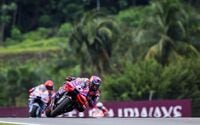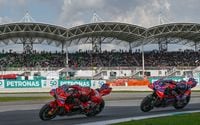At present it’s impossible not to notice the aerodynamic devices on MotoGP bikes, but 10 years ago there was no such thing; fairings were as smooth and free of “gadgets” as they were in the days of “One man, one cylinder, a Lucas magneto, and an Amal carburetor.”
The first step (around 2016) was to try something that had been tried years before: little winglets on the lower sides of the fairing nose, short and stubby like the “turbulators” once seen on the upper surfaces of B707 wings. John Britten once brought a bag of stick-on turbulators to Daytona for possible use. Winglet purpose was to produce a bit of downforce, thereby allowing riders to use a little more throttle when accelerating, without having the front wheel lift off the pavement. Always remember that electronic anti-wheelie systems work by reducing throttle just enough to keep the front tire steering.
Aero downforce is something different, for by adding a few pounds of downforce, it allows the use of somewhat stronger acceleration, without triggering the throttle cuts produced by anti-wheelie systems. Downforce can also assist braking from higher speeds.
Pundits rooted in the past saw this “winglet stubble” as an offense against purity. Dani Pedrosa reasonably called them “blades.”
Why were they being adopted? Because they offered potential for higher performance. What sponsor wants to display its message off-camera, back in sixth, seventh, and eighth place? Do something! Engineers constantly discuss possibilities. How can we soften problem X? Where can we apply previously ignored effects? There are always many more ideas than there is funding to develop them
Any aero device that produces lift (or its opposite, downforce) also produces drag. The ratio of the two, L/D, measures how efficiently lift is being produced. For commercial airliners in cruise this is 15–20, but sailplane L/D can be well over 30. The likely L/D of early winglets was poor since much of the flow spilled over their wingtips: maybe 3! To minimize tip losses, subsonic wings are made long and slender.
Aero devices were especially attractive to Ducati because:
- It needed a new technology to break out of a long period of indifferent results.
- It had excess horsepower that could be used to push downforce devices through the resisting air.
- Its fund-raisers have a history of success.
For safety, the next-gen winglets were made in vertical pairs, their tips joined by a vertical member that made them look like handles. In early days these “handles” were a Ducati signature, but lately the upper ones are evolving into ducts whose outlets are aimed upward.
The other basic downforce design originated with Aprilia and is now part of Yamaha’s “new look” fairings. An array of two or three airfoils is attached to the chin of the fairing nose, high enough in the center to clear the front tire on full compression, but drooping downward on either side like a comic moustache.
Total width is regulated, as is how far forward aero devices can be located.
Why multiple airfoils with slots between, rather than a single wide-chord foil? The slots between airfoils allow higher-pressure air to flow onto the lower-pressure surface of the next airfoil behind, to energize its boundary layer, postponing flow separation and so increasing lift. Such arrays are seen on the noses of F1 cars, and if you are seated behind the wing on your next commercial flight, you can see them during landing as the multi-element flap system.
Note that the purpose of downforce in F1 is quite different. Its job is to press the tires down against the pavement more firmly (without adding weight that would reduce acceleration and whose inertia would make cars tend to run wide in corners). With tire grip increased by downforce, F1 cars can go around corners faster. A problem is that downforce is roughly proportional to the square of the car’s speed, so there is much less downforce in first-gear corners than there is in fast upper-gear sweepers.
On a bike leaned at 45 degrees in a corner, downforce pushes just as hard to make the bike run wide as it does to press the front tire harder against the pavement. The higher the lean angle, the more the force tends to make the bike run wide.
The purpose of MotoGP downforce is only this: to allow the rider to accelerate harder without causing the anti-wheelie system to begin cutting throttle.
Later, S-shaped “downwash ducts” began to appear on the fairing sides at about the level of the front axle. After taking in air, they turn downward to direct their flow to where it can perform useful work: keeping air flowing at high speed under the lower part of the fairing side that is near parallel with the pavement at full lean. The aim here is to create a venturi (a passage that narrows, then widens again) flow whose low pressure creates downforce.
The glorious moment of downforce-generated tire grip in auto racing was Jim Hall’s Chaparral 2J “sucker car” of 1970, which used blowers to evacuate the under-car space, while skirts sealed that space against the pavement. The beauty of this system was that it created constant downforce—the same when parked as at high speed. It was banned because the system picked up track debris and blew it out at following vehicles.
The way around that was to keep the skirts and shape the under-surface of the car as a venturi. Ram air entered at the front, passed through the venturi, and exited to the rear.
When movable skirts were banned, near-rigid suspension was used to maintain skirt clearance. Another fruitful scheme was to employ exhaust-driven ejectors to further energize the flow through under-car venturi tunnels, one on either side of driver and engine/transmission. By terminating the exhaust outlets in the venturi exit ducts, exhaust energy swept along, or “pumped” the air in the ducts, increasing the partial vacuum created under the car. Ejectors were previously used to increase cooling airflow on Convair twin-engine airliners (1948) and on the DHC C-7 cargo plane (1958).
Wags suggest that F1 management needs a typing pool to keep up with the banning of new ideas. In the case of exhaust ejectors F1 forbade making a hole in the car’s under-surface. No more exhaust-blown venturis.
Since then, an F1 rules minuet has alternated between venturi shapes and spec flat bottoms.
In MotoGP, in-corner downforce is at an early stage. People speak of riders feeling their way with the strange new force, which is both lean-angle dependent and speed dependent. Here I have to mention the angled “sharkfin” arrays often seen on seatbacks. Every team has in some degree a lack of rear grip: In-corner and at high lean, the near-horizontal fin elements add some downforce.
Spoons? This name has stuck to aero devices located just ahead of where the rear tire meets the road. Normally this zone would be turbulent from the passage of the front wheel, but with the work being done to push or pull air under the fairing side panel, as it glides along in close proximity to the pavement, there may be enough flow energy to make a bit of downforce. Rear grip needs help!
Although nothing to do with downforce, all MotoGP constructors must deal with radiator exit air to prevent rider overheating. This can mean ducting rad air to the rear by sealing the fairing sides to the chassis beams or incorporating some rad air into upflows already created at the sides as part of downforce generation. You can be sure that consideration is being given to the idea of assisting front-to-rear hot airflow with the exhaust ejector effect described above.













/cloudfront-us-east-1.images.arcpublishing.com/octane/BXSKQM3G7JEQ3MLF2FS2G323KM.jpg)

/cloudfront-us-east-1.images.arcpublishing.com/octane/RVALYVU545DSZCFWKTXVBYCNC4.jpg)
/cloudfront-us-east-1.images.arcpublishing.com/octane/RO36KTIVYZEATJW7CCB77EQHLQ.jpg)
/cloudfront-us-east-1.images.arcpublishing.com/octane/BUIUXSLF5RFRVJ3E26VRO5V2AY.jpg)
/cloudfront-us-east-1.images.arcpublishing.com/octane/EJJ2JBBSEZAWLFCRDALQOIBFVU.jpg)
/cloudfront-us-east-1.images.arcpublishing.com/octane/WVYKJFMINVFMFH37AE4OUEWVIM.jpg)

/cloudfront-us-east-1.images.arcpublishing.com/octane/JJ3MC6GNDFF5ZNYD3KD3E4EY7Y.jpg)
/cloudfront-us-east-1.images.arcpublishing.com/octane/XH2ETEU4NVGDFNQO2XT2QQS5LU.jpg)
/cloudfront-us-east-1.images.arcpublishing.com/octane/UFG652C27BDBFPK42TDAJ5CMX4.jpg)
/cloudfront-us-east-1.images.arcpublishing.com/octane/AUE3NFVRRZDSBIDVUGIYIDQNUI.jpg)
/cloudfront-us-east-1.images.arcpublishing.com/octane/LYR62CH2WNBMHJJVXVATZHOUE4.jpg)
/cloudfront-us-east-1.images.arcpublishing.com/octane/RBCTRGBQYBDK7A6XPG3HKPS7ZQ.jpg)
/cloudfront-us-east-1.images.arcpublishing.com/octane/MQXQRYMZVBCWJIRYP3HEN3SHVE.jpg)
/cloudfront-us-east-1.images.arcpublishing.com/octane/TSPODNNEWRDSVJGUCNQTDG4ADI.jpg)
/cloudfront-us-east-1.images.arcpublishing.com/octane/X5TB7BDV4BA2RPSY54ZGK27RP4.jpg)
/cloudfront-us-east-1.images.arcpublishing.com/octane/REUHOJXRDBGZ5IHBYZCCBCISPA.jpg)
/cloudfront-us-east-1.images.arcpublishing.com/octane/52LGJTCKBFEHDF7S7H4CVUIMGM.jpg)
/cloudfront-us-east-1.images.arcpublishing.com/octane/YMWAIPIPSJAOXOU3QMJMGH37OM.jpg)


/cloudfront-us-east-1.images.arcpublishing.com/octane/EJ6KZRGAYBCVXNL2PJXL37UVWQ.jpg)
/cloudfront-us-east-1.images.arcpublishing.com/octane/AAN4TI76M5H5JMUVEIGASWXBDU.jpg)
/cloudfront-us-east-1.images.arcpublishing.com/octane/P3RXD2UCPFF37CMB7CHPVKXORY.jpg)
/cloudfront-us-east-1.images.arcpublishing.com/octane/VZEG2EJI2RDFZNHLRZMU56MD3Q.jpg)
/cloudfront-us-east-1.images.arcpublishing.com/octane/GVJQO5FFOFBWNGODOBRB4FBAW4.jpg)